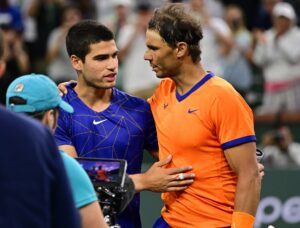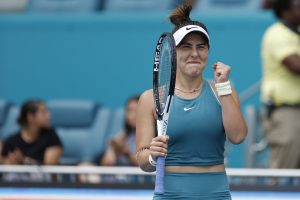This installment of “The Greatest: The Men And Women Who Made Tennis” is a twofer, or two for the price of one, as it not only looks at statistically the single greatest season in tennis history – John McEnroe’s remarkable 1984 campaign – but at the best visual record of that season, Julien Faraut’s superb documentary In The Realm Of Perfection (2018), which is arguably the greatest film about tennis (fiction or non-fiction) ever made. Both the season itself and Faraut’s film about it, which ironically focuses on a rare defeat for McEnroe that year at the French Open, stand as twin testaments to the troubled greatness of John McEnroe, the man who probably played the greatest tennis ever by anyone who did not seem to derive any enjoyment from it whatsoever.
At the start of the year made famous by George Orwell (who came up with the title “1984” for his dystopian novel simply by reversing the last two digits of the year in which he wrote it, 1948), John McEnroe was already a truly great tennis player. He was the reigning Wimbledon Champion, having won the Wimbledon Men’s Singles title for a second time in 1983 after his famous triumph over Bjorn Borg in 1981, and he had already won a hat-trick of US Opens between 1979 and 1981. However, over the course of the next 12 months, he would play tennis of such a stunningly high standard, especially in terms of skill, flair and sheer imagination, that it would probably not be consistently matched for nearly two decades and the arrival of the sublime Swiss, Roger Federer. Indeed, ultimately McEnroe himself was unable to match it, to the extent that he would not win another Major title after his tennis annus mirabilis.
In 1984, the tennis calendar was very different to the one that we have become accustomed to in the last few decades, at least until the Coronavirus pandemic threw the tennis calendar (and seemingly everything else) up into the air. Back then, the tennis year did not start, as it does now, with the Australian Open. Instead, the Australian Open was played near the end of the calendar year, in the Australian summer rather than winter, and it was only in 1986 that the last Major of the year became the First Major of the year, with the result that there was no Australian Open at all that year, so that it could begin again with a bang in 1987.
What this meant for McEnroe and every other tennis player in 1984 was that they enjoyed probably a gentler introduction to the season than is the case now, when the world’s best players compete for one of the sport’s four greatest prizes less than a month after the start of the season. That probably suited McEnroe down to the ground, as it enabled him to find his feet and form without facing the pressure of a Major tournament. Even so, he certainly made the most of this fortuitous scheduling by embarking on the greatest winning streak ever seen in men’s tennis, winning – incredibly – his first 42 matches of the year. It would be more than a quarter of a century, and Novak Djokovic’s similarly dominant start to the 2011 season, before anyone came close to matching McEnroe’s astonishing winning start in 1984. And even then Djokovic could not quite match it, winning his first 41 matches of the year before losing to Roger Federer in the French Open semi-finals.
Unlike Djokovic in 2011, McEnroe made the French Open Final in 1984, but he ultimately lost a five-set classic to Ivan Lendl, 3–6, 2–6, 6–4, 7–5, 7–5, after appearing almost unbeatable for the first two sets. Fortunately for tennis fans who were not alive at the time, Julien Faraut’s film, In The Realm Of Perfection, which used footage from the time but was only released more than three decades later, gives some idea of the madness and majesty of McEnroe that springtime in Paris. In addition to being a kind of “Brief History of Tennis” and a very basic primer for anyone unversed in the rules of the sport (in the process using animation and “talking heads” as well as documentary footage from the tournament), it stands as the best document imaginable of McEnroe in his prime, when he was not only one of the most talented if temperamental figures in the history of tennis but in all of sporting history. In the 95 minutes that the film runs to, McEnroe does not seem to smile once, despite playing the most outrageous serve-volley tennis ever seen anywhere, let alone on the red dirt of Roland Garros, which is famously hostile to serving and volleying of any kind.
In fact, In The Realm Of Perfection is such a great film that it is one of those real rarities – a great film that absolutely demands a sequel. Perhaps such a sequel could be entitled “Attaining Perfection”, because that is more or less what McEnroe did after losing to Lendl in Paris. Despite the fact that there was less than a fortnight’s turnaround between the end of the French Open and the start of Wimbledon, McEnroe effortlessly transitioned from clay to grass. Indeed, so brilliant was his play for the rest of 1984 that it was as if he was determined to take out all the frustration he felt in Paris (and in Faraut’s film McEnroe admits to being “haunted” by that French Open Final defeat) on every other opponent that he faced for the rest of the calendar year.
First, at Wimbledon, where McEnroe had broken through as an unseeded 18-year-old amateur when he made the semi-finals in 1977, he played a tournament for the ages, perhaps the single greatest set of seven games that anyone – male or female – has ever played on the famous lawns of London SW19. He swept aside a young Pat Cash in the semi-finals. Then, after Jimmy Connors had defeated his Paris nemesis Lendl in the other semi-final, McEnroe subjected Connors to one of the all-time great tennis eviscerations in the Final. He beat Connors 6–1, 6–1, 6–2, a performance in a Major Final that was so crushing it would take another three and a half decades for it to be matched, by Novak Djokovic’s annihilation of Rafael Nadal at last year’s Australian Open.
Then, just over two months later at the US Open, McEnroe went one better, as it were, first beating Connors again in the semi-final, although that was a five-set thriller as opposed to the Wimbledon exhibition match, before gaining some kind of revenge over Lendl for Paris by beating him in straight sets in the Final, 6–3, 6–4, 6–1. Having lost to Lendl from two sets up in the Spring, he was in no mood to let up in New York, totally dominating the third set – indeed, almost bagelling Lendl – rather than losing it as he had in France. Indeed, that famous loss to Lendl at the French Open was the only time in 1984 that McEnroe, the World No.1 by a distance, lost to either Connors or Lendl, the World No.2 and World No.3 respectively.
https://www.youtube.com/watch?v=7iCeXEXxDQY
However, the end of 1984 was not quite as memorable for McEnroe as the months that had preceded it. First, he reverted to tempestuous type at a tournament in the Swedish capital, Stockholm, verbally abusing an umpire after a questionable call and then virtually destroying a drinks trolley with his racket. In turn, that led to a three-week ban from the ATP Tour, during which time (and perhaps because of the frustration he felt at not playing when he was at his absolute peak) he injured his left wrist, the fulcrum of his classic “lefty” style of play, and was subsequently unable to compete at the year’s last Major, the Australian Open, where he would have been the strong favourite to win. (In McEnroe’s absence, Sweden’s Mats Wilander won in Melbourne for the second year in succession.)
Nevertheless, as the superb ending of In The Realm Of Perfection demonstrates, McEnroe still achieved tennis immortality in 1984. That was because he played a total of 85 matches, losing only three, for a frankly unbelievable winning percentage all season of 96%, which not even The Great Three of Federer, Nadal and Djokovic have come close to matching (not least, of course, because of the demands of their own unique “Trivalry”).
For McEnroe, however, it was all downhill from there. As if the tennis Gods were angry that a mere mortal had come so close to achieving absolute perfection (a season-long winning record of 100%), McEnroe subsequently became a kind of tennis equivalent of Icarus – a truly great player who had flown so close to the sun that inevitably he had to crash-land. After an indifferent season in 1985, when he failed to win a Major of any kind for the first time in six years (indeed, he only reached one Major Final, at the US Open, which he lost in straight sets to Lendl), he took a break from the tour, married Hollywood wild child Tatum O’Neal (who was almost the artistic equivalent of his own sporting genius-demon) and never recaptured the greatness of old. Nevertheless, for one astonishing season, the rare low-point of which was captured in one astonishing film, John McEnroe played tennis of such sheer artistry that even the greatest tennis artist of them all, Roger Federer, has failed to match it over the course of a whole season.
Main Photo:






